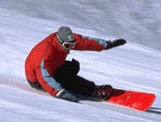|
Cardiovascular
Training
Cardiovascular
conditioning trains the ability of the three major systems (pulmonary,
cardiovascular, and muscular) to take in, transport and utilize
oxygen. Improving these systems increases your total work capacity.
What you get out of it are more rides down the mountain without
running out of steam! Check out the details below.
The
Details
|
Frequency:
|
3-5 days
per week |
|
|
|
|
Intensity:
|
| Heart
rate monitoring: |
When
you exercise, the heart beats faster to meet the demand
for more blood and oxygen by the muscles of the body.
The higher the intensity, the faster the heart will beat.
This is why heart rate monitoring can be your best coach!
It lets you know if your working too hard or not hard
enough. To find your estimated target heart rate Take
"220 - age x .60 = Low end of training heart rate"
then take "220 - age x .85 = High end of training
heart rate" For general conditioning keep on the
low end of the training heart rate. For higher intensity
keep on the higher end of the training heart rate. For
interval training try one minute at the high end, then
one minute at the low end. Alternate for 15 - 20 minutes.
Remember this is just an estimate. If you feel like you're
exercising too hard, you probably are. Reduce the intensity.
|
|
|
| Perceived
exertion: |
Another
way to monitor exercise intensity is by ratings of perceived
exertion (RPE); basically, how you feel overall when you
exercise. I prefer perceived exertion because of the fact
that sensory input from the muscles, joints, breathing
rate, and heart rate are taken into consideration. It's
also easy to use. Used by itself or in conjunction with
heart rate monitoring provides a excellent way to gauge
how hard you're working. How to Use RPE: On a scale between
1 (no exertion at all) and 10 (the hardest you have ever
physically worked), train between 4 and 6 for general
conditioning. For advanced interval workouts try alternating
one minute at 5 then one minute at 7. Repeat for 15 -
20 minutes |
|
|
|
|
|
Duration:
|
30 - 45
minutes for general conditioning. 15 - 20 minutes for interval
training |
|
|
|
|
Activity
choice:
|
Any activity
that uses the large muscle groups, you can maintain the required
time and intensity, and is aerobic in nature (e.g., running,
jogging, hiking, swimming, biking, stair climbing, rowing....).
Many sport activities may qualify as cardiovascular conditioning
as long as they maintain intensity for a extended period of
time. Many riders favor the jump-rope for its combined cardiovascular
and plyometric effect. |
|


